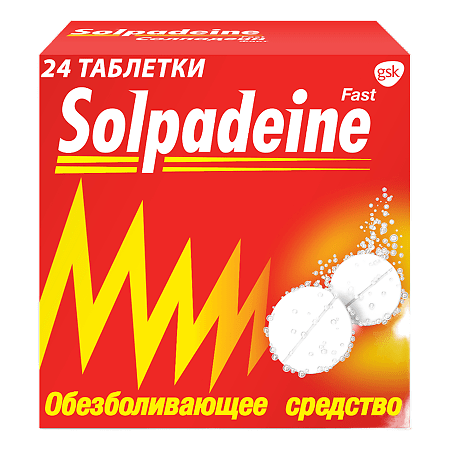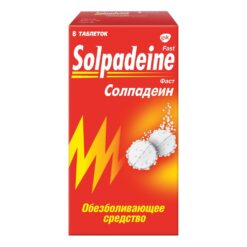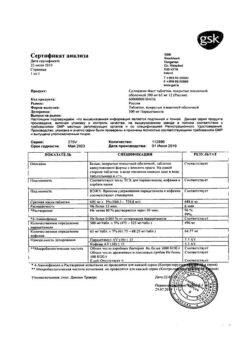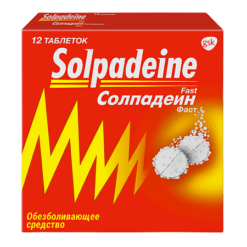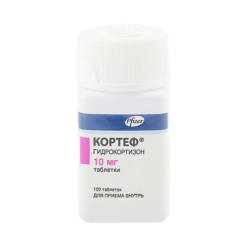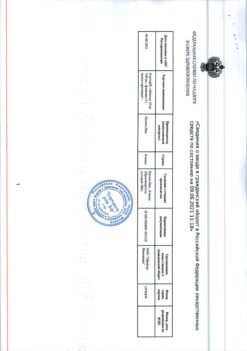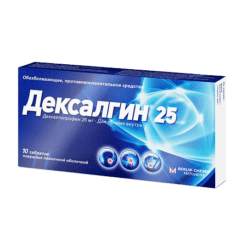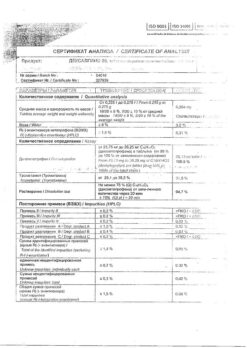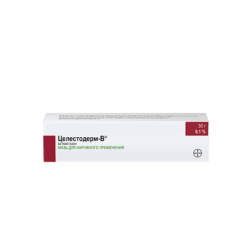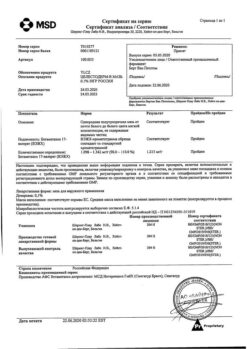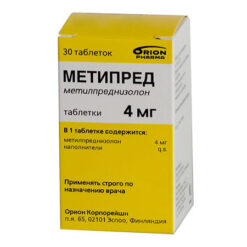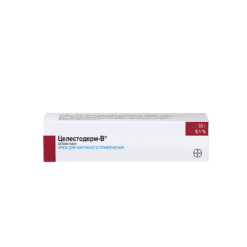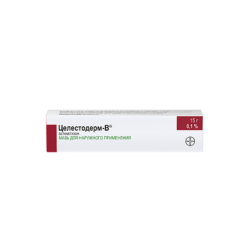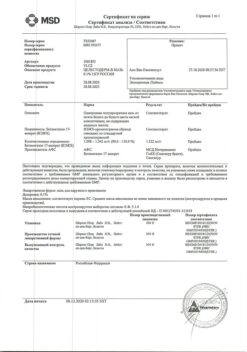No products in the cart.
Solpadein Fast, 65 mg+500 mg 24 pcs
€17.42 €14.51
Description
Pharmacological group:
Analgesic and antipyretic
ATX code: N02BE51.
Pharmacodynamics:
The drug Solpadein Fast has analgesic and antipyretic effect. The drug contains a combination of two active ingredients: paracetamol and caffeine.
Paracetamol
Paracetamol blocks cyclooxygenase (COX) in the central nervous system, affecting the centers of pain and thermoregulation (in inflamed tissues cell peroxidase neutralizes the effect of paracetamol on COX), which explains the almost complete absence of anti-inflammatory effect. The lack of effect on the synthesis of prostaglandins in peripheral tissues determines its lack of negative effect on water-salt metabolism (sodium and water retention) and gastrointestinal mucosa. This property of paracetamol makes the drug especially suitable for patients with a history of gastrointestinal diseases (e.g., patients with a history of gastrointestinal bleeding or elderly patients) or patients taking concomitant medication, in which inhibition of peripheral prostaglandins may be undesirable.
Caffeine
The analgesic adjuvant action of caffeine is due to the following mechanisms: blockade of peripheral pronociceptive action of adenosine, activation of central noradrenergic pathways, which is an endogenous system of pain suppression, and CNS stimulation with subsequent modulation of the effective pain component. Caffeine enhances the effect of paracetamol and shortens the time to the onset of analgesic effect. Clinical data have shown that the paracetamol-caffeine combination provides more effective pain relief than just paracetamol (p < 0.05). Also caffeine stimulates psychomotor centers of the brain, has an analeptic effect, enhances the effect of analgesics, eliminates drowsiness and fatigue, increases physical and mental performance.
Sodium bicarbonate has no analgesic effect.
Pharmacokinetics:
Absorption and distribution:
Paracetamol is quickly and almost completely absorbed from the gastrointestinal tract. Distribution in body fluids is relatively uniform. At therapeutic concentrations, the binding of paracetamol to plasma proteins is minimal. There is no saturation of the excretion of paracetamol with the subsequent risk of increased elimination half-life and toxicity. No interaction of active substances was noted.
Caffeine is completely and quickly absorbed from the gastrointestinal tract. Maximal concentrations are reached in 5-120 minutes depending on the dose, patient’s condition and concomitant drugs. No evidence of presystemic metabolism has been recorded. Caffeine is actively distributed throughout the body. Average binding of caffeine to plasma proteins is about 35 %.
The drug contains sodium bicarbonate, which promotes absorption of the drug. According to clinical studies, absorption of paracetamol and caffeine is faster during the first 60 minutes (decrease in Tmax and increase in AUC0-10 h) compared to the drug Solpadein Fast, film-coated tablets.
Metabolism:
Paracetamol is metabolized in the liver and excreted by the kidneys as glucuronide and sulfate metabolites – less than 5% is excreted as unchanged paracetamol.
Caffeine is almost completely (~99%) metabolized in the liver by oxidation and demethylation to various xanthine derivatives, which are excreted by the kidneys. The hepatic cytochrome P450 isoenzyme CYP1A2 is involved in the enzymatic metabolism of caffeine.
Excretion:
In adult patients, caffeine is almost completely excreted by hepatic metabolism. Only a small amount (1-2%) of the taken dose of caffeine in humans is excreted unchanged by the kidneys. In adults, there is individual variability in excretion rate. The average blood elimination half-life of caffeine at a therapeutic dose is about 4.9 hours, with a range of 1.9-12.2 hours.
Indications
Indications
The drug Solpadeine Fast is used in adults and children over 12 years of age as:
• Anesthetic (for pain of mild to moderate intensity) for:
– toothache, including during tooth extraction and after dental interventions;
– headaches and migraines;
– sore throat;
– pain in muscles and joints, including lower back pain;
– pain caused by osteoarthritis;
– ear pain (otalgia);
– neuralgia;
– painful menstruation (dysmenorrhea).
• As a symptomatic treatment to reduce elevated body temperature in:
– acute respiratory and acute respiratory viral diseases, including influenza;
– after vaccination.
Pharmacological effect
Pharmacological effect
Pharmacological group:
Analgesic and antipyretic
ATX code: N02BE51.
Pharmacodynamics:
The drug Solpadeine Fast has an analgesic and antipyretic effect. The drug contains a combination of two active ingredients: paracetamol and caffeine.
Paracetamol
Paracetamol blocks cyclooxygenase (COX) in the central nervous system, affecting the centers of pain and thermoregulation (in inflamed tissues, cellular peroxidases neutralize the effect of paracetamol on COX), which explains the almost complete absence of anti-inflammatory effect. The lack of influence on the synthesis of prostaglandins in peripheral tissues determines the absence of a negative effect on water-salt metabolism (sodium and water retention) and the mucous membrane of the gastrointestinal tract. This property of paracetamol makes the drug particularly suitable for patients with a history of gastrointestinal disease (for example, patients with a history of gastrointestinal bleeding or elderly patients) or patients taking concomitant medications in which inhibition of peripheral prostaglandins may be undesirable.
Caffeine
The analgesic adjuvant effect of caffeine is due to the following mechanisms: blockade of the peripheral pronociceptive action of adenosine, activation of central noradrenergic pathways, which are the endogenous pain suppression system, and stimulation of the central nervous system with subsequent modulation of the effective pain component. Caffeine enhances the effect of paracetamol and shortens the time until the analgesic effect occurs. Clinical data showed that the combination of paracetamol and caffeine provided more effective pain relief compared to paracetamol alone (p < 0.05). Caffeine also stimulates the psychomotor centers of the brain, has an analeptic effect, enhances the effect of analgesics, eliminates drowsiness and fatigue, and increases physical and mental performance.Sodium bicarbonate does not have an analgesic effect.Pharmacokinetics:
Suction and distribution:
Paracetamol is quickly and almost completely absorbed from the gastrointestinal tract. Distribution in body fluids is relatively uniform. At therapeutic concentrations, the binding of paracetamol to plasma proteins is minimal. There is no saturation of the elimination processes of paracetamol with subsequent risks of increased half-life and toxicity. No interaction of active substances was observed.
Caffeine is completely and quickly absorbed from the gastrointestinal tract. Maximum concentrations are reached after 5-120 minutes, depending on the dose, patient condition and concomitant medications. No signs of first pass metabolism were recorded. Caffeine is actively distributed throughout the body. The average binding of caffeine to plasma proteins is about 35%.
The drug contains sodium bicarbonate, which promotes absorption of the drug. According to clinical studies, the absorption of paracetamol and caffeine is faster during the first 60 minutes (decrease in Tmax and increase in AUC0-10 h) compared to the drug Solpadein Fast, film-coated tablets.
Metabolism:
Paracetamol is metabolized in the liver and excreted by the kidneys in the form of glucuronide and sulfate metabolites; less than 5% is excreted as unchanged paracetamol.
Caffeine is almost completely (~99%) metabolized in the liver through oxidation and demethylation to various xanthine derivatives, which are excreted by the kidneys. The hepatic cytochrome P450 isoenzyme CYP1A2 is involved in the enzymatic metabolism of caffeine.
Removal:
In adult patients, caffeine elimination occurs almost entirely through hepatic metabolism. Only a small amount (1-2%) of an ingested dose of caffeine in humans is excreted unchanged by the kidneys. In adults, there is individual variability in the rate of excretion. The average blood half-life of caffeine at a therapeutic dose is approximately 4.9 hours, with a range of 1.9-12.2 hours.
Special instructions
Special instructions
If no improvement is observed while taking the drug, or the headache becomes constant, you should consult a doctor.
The drug Solpadein Fast should not be used with other paracetamol-containing drugs, since taking the drugs together can cause an overdose of paracetamol.
An overdose of paracetamol may cause liver failure, which may lead to the need for a liver transplant or death.
The drug Solpadeine Fast should not be taken with caffeine-containing foods (tea, coffee, etc.), because this can lead to restlessness, anxiety, irritability, insomnia, headache, gastrointestinal disorders, tachycardia, cardiac arrhythmia.
Patients with glutathione deficiency due to an eating disorder, cystic fibrosis, HIV infection, fasting, malnutrition are susceptible to overdose, so precautions must be taken and it is recommended to consult a doctor before taking the drug. Cases of liver failure/impaired liver function have been reported with a small overdose of paracetamol (5 g or more) in patients with low glutathione levels, in particular in extremely malnourished patients suffering from anorexia, chronic alcoholism or patients with a low body mass index.
The use of Solpadeine Fast by patients with low glutathione levels, for example, with sepsis, may increase the risk of developing metabolic acidosis, accompanied by symptoms of rapid, difficult breathing (feeling of shortness of breath, shortness of breath), nausea, vomiting, loss of appetite. If these symptoms occur simultaneously, you should consult a doctor immediately.
To avoid toxic liver damage, paracetamol should not be combined with alcoholic beverages, or taken by persons prone to chronic alcohol consumption.
Concomitant liver diseases increase the risk of further liver damage when taking Solpadeine Fast. When taking the drug in patients with non-alcoholic cirrhosis of the liver there is a high risk of overdose. Patients suffering from atopic bronchial asthma and hay fever have an increased risk of developing allergic reactions.
When conducting tests to determine uric acid and glucose levels in the blood, you should inform your doctor about taking the drug.
The drug can change the results of doping control tests for athletes. For patients on a salt-free or low-salt diet, the sodium content of the tablet (427 mg) should be taken into account when calculating daily salt intake.
The drug contains sorbitol. Patients with fructose intolerance should not use this drug.
INFLUENCE ON THE ABILITY TO DRIVE VEHICLES AND MECHANISMS The effect of the drug on the ability to drive a car and operate machinery is unlikely.
Active ingredient
Active ingredient
Caffeine, Paracetamol
Composition
Composition
Active substance:
1 tablet contains: paracetamol 500 mg; caffeine 65 mg
Excipients: Sodium bicarbonate, citric acid (anhydrous), sodium carbonate (anhydrous), sorbitol, sodium saccharinate, povidone (K-25), dimethicone, sodium lauryl sulfate
Pregnancy
Pregnancy
Pregnancy:
The use of the drug during pregnancy is not recommended.
Paracetamol
The lowest dose needed to achieve effect should be taken for the shortest period of time.
Caffeine
The use of caffeine may increase the risk of spontaneous abortion, so its use is not recommended during pregnancy.
Breastfeeding period:
The use of the drug during breastfeeding is not recommended.
Paracetamol
Paracetamol is excreted in breast milk, but in clinically insignificant quantities when used in recommended doses.
Caffeine
Caffeine passes into breast milk and may have a stimulating effect on the breastfed infant, but no significant toxicity has been reported.
Contraindications
Contraindications
• Hypersensitivity to paracetamol, caffeine or any other component of the drug;
• Severe liver and kidney dysfunction;
• Arterial hypertension;
• Glaucoma, sleep disorders;
• Children under 12 years of age;
• Pregnancy and breastfeeding;
• Epilepsy;
• Sucrase/isomaltase deficiency, fructose intolerance, glucose-galactose malabsorption, because. the drug contains sorbitol.
• Concomitant use with other medications containing paracetamol, lithium, as well as caffeine-containing drinks.
With caution:
• Benign hyperbilirubinemia (including Gilbert’s syndrome);
• Viral hepatitis;
• Alcoholic liver disease;
• Chronic alcoholism;
• Glucose-6-phosphate dehydrogenase deficiency;
• Mild to moderate liver and kidney dysfunction;
• Presence of severe infections, because taking the drug may increase the risk of metabolic acidosis;
• Use in patients with glutathione deficiency (in particular, extremely malnourished patients suffering from anorexia or patients with a low body mass index).
If you have any of the listed diseases/conditions/risk factors, you should consult your doctor before taking the drug.
Side Effects
Side Effects
At recommended doses, the drug is usually well tolerated. The following adverse reactions were detected spontaneously during post-registration use of the drug.
Adverse reactions are classified according to body systems and according to the frequency of development. The frequency of adverse reactions is determined as follows: very often (> 1/10), often (> 1/100 and 1/1000 and 1/10,000 and <1/1000), very rare (< 10,000), frequency unknown (frequency cannot be estimated based on available data).Paracetamol:Blood and lymphatic system disorders: very rare: thrombocytopenia, leukopenia, methemoglobinemia, agranulocytosis, hemolytic anemia.Immune system disorders: very rare: anaphylaxis, skin hypersensitivity reactions including skin rash, angioedema (Quincke’s edema), Stevens-Johnson syndrome, toxic epidermal necrolysis.Respiratory, thoracic and mediastinal disorders: very rare: bronchospasm in patients with hypersensitivity to acetylsalicylic acid and intolerance to other non-steroidal anti-inflammatory drugs.Liver and biliary tract disorders: very rare: liver dysfunction.With long-term use of the drug in high doses, the likelihood of hepatotoxicity, nephrotoxicity and pancytopenia increases. In case of long-term use of the drug, monitoring of the blood picture is necessary.Caffeine:Central nervous system disorders: very rare: dizziness, headache.Cardiac disorders: very rare: palpitations.Mental disorders: very rare: insomnia, restlessness, anxiety, irritability, nervousness.Gastrointestinal disorders: very rare: gastrointestinal disorders.When using the drug Solpadein Fast, it is not recommended to take caffeine-containing products, because this increases the risk of adverse reactions such as insomnia, irritability, anxiety, headache, gastrointestinal disorders, tachycardia, cardiac arrhythmia.If any of the listed adverse reactions occur, stop taking the drug and consult your doctor immediately.
Interaction
Interaction
If the patient is already taking other medications, you should consult a doctor before starting Solpadeine Fast.
When taken regularly over a long period of time, the drug enhances the effect of indirect anticoagulants (warfarin and other coumarins), which increases the risk of bleeding. Occasional administration of a single dose of the drug does not have a significant effect on the effect of indirect anticoagulants. Enhances the effect of MAO inhibitors.
Barbiturates, carbamazein, phenytoin, primidone and other anticonvulsants, ethanol, rifampicin, phenylbutazone, butadione, preparations of St. John’s wort and other inducers of microsomal oxidation increase the production of hydroxylated active metabolites, causing the possibility of developing severe liver damage with small overdoses of paracetamol (5 g or more). Inhibitors of microsomal liver enzymes (cimetidine) reduce the risk of hepatotoxicity.
Under the influence of paracetamol, the elimination time of chloramphenicol (chloramphenicol) increases 5 times, resulting in an increased risk of chloramphenicol (chloramphenicol) poisoning.
Metoclopramide and domperidone increase, and cholestyramine reduces the rate of absorption of paracetamol. The drug may reduce the effectiveness of uricosuric drugs.
The simultaneous use of paracetamol and alcoholic beverages increases the risk of developing liver damage and acute pancreatitis.
Caffeine accelerates the absorption of ergotamine. The drug should not be taken simultaneously with caffeine-containing products.
Caffeine may enhance the excretion of lithium from the body, so simultaneous use of the drug with lithium-containing drugs is not recommended.
Overdose
Overdose
Symptoms (due to paracetamol):
An overdose of paracetamol can cause liver failure, which may lead to the need for a liver transplant or death. In addition, acute pancreatitis is observed, accompanied by liver dysfunction and hepatotoxicity.
The hepatotoxic effect in adults occurs when taking paracetamol in amounts of 10 g or more. If there are factors influencing the toxicity of paracetamol to the liver (see sections “Interaction with other drugs”, “Special instructions”), liver damage may occur after taking paracetamol in an amount of 5 g or more.
The first signs of overdose usually appear after 24-48 hours and reach their maximum development on days 4-6. During the first 24 hours after an overdose, the following symptoms may appear: nausea, vomiting, stomach pain, pale skin, anorexia. After 1-2 days, signs of liver damage are determined (pain in the liver area, increased activity of “liver” enzymes), and possible development of carbohydrate metabolism disorders and metabolic acidosis.
In severe cases of overdose, encephalopathy (impaired brain function), bleeding, hypoglycemia, cerebral edema, even death, the need for liver transplantation, and death may develop as a result of liver failure. It is also possible to develop acute renal failure with acute tubular necrosis, the characteristic signs of which are pain in the lumbar region, hematuria (admixture of blood or red blood cells in the urine), proteinuria (increased protein in the urine), while severe liver damage may be absent. There have been cases of heart rhythm disturbances and pancreatitis.
Treatment:
If you suspect an overdose of Solpadeine Fast, even in the absence of pronounced first symptoms, you must stop using the drug and immediately consult a doctor for medical assistance. During the first hour after an overdose, but no later than 4 hours, it is recommended to lavage the stomach and take enterosorbents (activated carbon, polyphepane). The concentration of paracetamol in the blood plasma should be determined, but not earlier than 4 hours after the overdose (earlier results are unreliable).
Administration of acetylcysteine within 24 hours after an overdose. The maximum protective effect is ensured during the first 8 hours after an overdose; over time, the effectiveness of the antidote drops sharply. If necessary, acetylcysteine is administered intravenously. In the absence of vomiting, methionine may be used before the patient is admitted to the hospital.
The need for additional therapeutic measures (methionine intake, intravenous acetylcysteine) is determined depending on the concentration of paracetamol in the blood plasma, as well as the time elapsed after its administration.
Treatment of patients with severe liver dysfunction 24 hours after taking paracetamol should be carried out in conjunction with specialists from a poison control center or specialized liver disease department.
Symptoms (due to caffeine):
Epigastric pain, vomiting, frequent urination, tachycardia, arrhythmia, stimulation of the central nervous system (insomnia, restlessness, agitation, anxiety, increased neuro-reflex excitability, tremor and convulsions). It should be borne in mind that the appearance of clinically significant symptoms of caffeine overdose when taking the drug is always associated with severe liver damage due to an overdose of paracetamol.
Treatment:
There is no specific antidote. Treatment includes supportive measures, such as drinking plenty of fluids and maintaining vital signs. Within 1 hour to 4 hours after an overdose, it is recommended to take activated carbon. To reduce the effects of caffeine on central nervous system function, intravenous sedatives and beta-adrenergic receptor antagonists are recommended to reduce the cardiotoxic effect.
High doses of sodium bicarbonate may cause gastrointestinal symptoms including nausea and vomiting. In addition, high doses of sodium bicarbonate can cause hypernatremia.
If hypernatremia is suspected, the patient’s electrolyte levels should be monitored and treated accordingly.
Manufacturer
Manufacturer
GlaxoSmithKline Dungarvan Limited, Ireland
Additional information
| Manufacturer | GlaxoSmithKlein Dungarvan Limited, Ireland |
|---|---|
| Medication form | instant tablets |
| Brand | GlaxoSmithKlein Dungarvan Limited |
Other forms…
Related products
Buy Solpadein Fast, 65 mg+500 mg 24 pcs with delivery to USA, UK, Europe and over 120 other countries.

